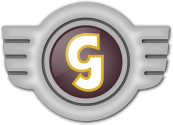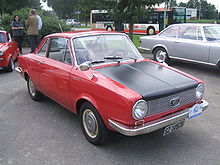Hans Glas GmbH
| Hans Glas GmbH
|
|
|---|---|
| legal form | Company with limited liability |
| founding | 1883 (as a glass agricultural machinery factory ) |
| resolution | 1966 |
| Reason for dissolution | Takeover by BMW |
| Seat | Pilsting / Dingolfing , Germany |
| management | |
| Branch | Agricultural machinery manufacturer , automobile manufacturer |
The Hans Glas GmbH in Dingolfing was a German agricultural machinery and later automobile manufacturer.
Reorientation
The family business agricultural machinery factory Glas was founded in Pilsting in 1883 . When the demand for agricultural machinery declined in the 1940s, the company was forced to reorient itself. Due to the great success of the Vespa in Italy , the company expected a demand for scooters in post-war Germany as well . Therefore, under the direction of junior boss Andreas Glas, the development of a scooter began, which went into series production in July 1951 with a 123 cc two-stroke engine from ILO-Motorenwerke . Seed drill production was relocated to a plant in Pilsting that was taken over in 1951. The scooter was named after a grandson of Hans Glas with the nickname "Gogg". The Goggo scooter turned out to be solid and robust and became the best-selling scooter in West Germany (approx. 60,000 pieces). From 1952 it was also offered with 148 cm³ and 197 cm³ engines and with a sidecar, and from 1953 as a three-wheeled cargo scooter with various bodies. In 1954 Glas bought the Erich Röhr machine factory in Landshut. In 1956, Glas stopped building scooters after the economic basis for car construction was solidified and the two-wheeler boom came to an end. Agricultural machinery was sold under the Isaria brand .
"Isaria" seed drill in the fortified church museum in Mönchsondheim
Motorcycle prototypes developed in 1953 did not go into series production.
Goggomobil

In 1952, Glas started developing a small car. From 1955, Glas offered the Goggomobil , intended for a family of four, under the Goggomobil brand at a price of DM 3,000 . In the following years, different versions of this vehicle with a maximum of 20 hp and 400 cm³ were created .
Since the Goggomobil was superior to its German competitors, the Messerschmitt cabin scooter , the BMW Isetta , the Lloyd and the Heinkel cabin, in terms of technology and its overall concept , Hans Glas GmbH was able to establish itself on the market. A year after the start of production, glass was exported to 36 countries. 170 vehicles were produced every day. In 1957 Glas developed a coupé version of the Goggomobil as well as a van and a pick-up van.
Expansion of the product range
Nevertheless, the Goggomobil remained nothing more than a miniature car , and as such it was no longer so popular with increasing prosperity . Glass had to expand the model range.
Glas Isar
In 1958 the company brought the Isar onto the market, which was nicknamed the great Goggomobil . It was powered by a 600 cc two-cylinder four-stroke boxer engine that developed 19 hp. Later, a station wagon and a model with 700 cm³ and 30 hp were built. Due to initial shortcomings, the vehicle's success was rather moderate. Production was stopped in 1965. In 1959, the Isar 35S prototype was presented at the IAA . It was a mix between Goggo Coupé and Isar T700. A 34 hp four-stroke boxer engine was provided for the drive.
Glass 1004, 1204, 1304
In 1962, Glas presented a new four-cylinder engine . With 1000 cubic centimeters and 42 hp, this represented a modern engine concept and was the first mass-produced automobile engine with a toothed belt for driving the camshaft . This engine gave the newly designed Coupé S1004 sporty qualities. The vehicle was also very successful on the racetracks, especially in the TS versions that were later available, with up to 85 hp as standard, and was considered the little man's Porsche . In contrast, the body was more conventional or took some getting used to for the eye. The program was later expanded to include a sedan and a convertible . From 1966, Glas also offered a hatchback sedan with the CL version. As the engines got bigger and more powerful, glass became a serious competitor for other vehicle manufacturers. The models available were Glas 1004 , 1204 and 1304 and were produced until 1968.
Glass 1300 GT, 1700 GT
In 1963, at the IAA in Frankfurt , Glas presented the Glas 1300 GT sports coupé and the 1500 sedan , which later went into series production as Glas 1700 . Both models were designed by the Italian designer Pietro Frua . Glass had thus advanced into the upper price ranges, for which the company lacked the reputation and tradition . In 1967 the production of the sports coupés was stopped.
Glass 1700
The Glas 1700 was a newly developed sporty mid-range car. It was built from September 1964 to the end of 1967 in a number of 13,789 copies. Elegant lines ( Frua originally designed the body for Borgward as the Hansa -1100 successor) and the timing belt used by Glas as the first manufacturer in engine construction characterize this sedan. Originally planned as Glas 1500 with 51 kW (70 HP), the displacement had to be. a. be enlarged by the appearance of the BMW 1800. The Glas went into series production as the 1700 with 59 kW (80 PS), later 63 kW (85 PS). In addition, a TS 'version with 74 kW (100 PS) was offered. After Glas was taken over by BMW, the Glas 1700 was built with BMW technology (engine / transmission) as the BMW 1800 GL and BMW 2000 GL , later with a facelift as the BMW 1804 and BMW 2004 in South Africa . The glass 1700 is a rarity today.
The end
Glass 2600 V8, 3000 V8 (1966–1968)

At the IAA in September 1965, Glas presented the Glas V8 . Its sleek shape, also drawn by Frua, earned it the nickname "Glaserati". However, only a small series was produced. The production costs were too high and the entire cost structure of the company had developed unfavorably. This meant that glass was unable to assert itself on the automotive market.
Takeover by BMW
Glas agreed to a takeover by BMW for 9.1 million DM on November 10, 1966. The Glas Automobilwerke in Dingolfing became part of the Bayerische Motorenwerke as the BMW factory in Dingolfing . Over time, the glass models were taken out of production. The last model rolled off the production line in 1969 was a Goggomobil. The Glas GT continued to be produced as the BMW 1600 GT with BMW engines and drivetrains in 1968. The Glas 2600 V8 was upgraded and manufactured as Glas / BMW 3000 V8 in small numbers until May 1968. The 1700 was still produced in South Africa as the BMW 1804 and 2004 with a few changes. A grandson of the company founder, also Hans Glas and brother of the aforementioned "Goggo", was plant manager of the BMW plant in Dingolfing from 1998 until his retirement in 2004. After a long illness, he died on January 23, 2008 at the age of 63.
The Goggomobil still enjoys numerous fans today. In the vicinity of Dingolfing there are still several glass museums with many Goggomobiles on display. The GLAS Automobilclub International eV (founded in 1975) looks after all existing glass vehicles and their owners worldwide with information, spare parts, a club magazine and an internet portal.
Glas passenger cars are listed at the Federal Motor Transport Authority under the manufacturer's key number 0598.
literature
- Andreas Schey, Hanns-Peter Baron von Thyssen-Bornemissza: Glass automobiles. Motorbuch-Verlag, Stuttgart 2009, ISBN 978-3-613-03027-5
Individual evidence
- ↑ http://www.markt-pilsting.de/portrait/geschichte/portrait-geschichte-pilsting/
- ↑ http://www.glasclub.de/index.php/de/32-sonstige-fahrzeuge/prototypen/113-glas-motorrad Retrieved on November 9, 2015
- ↑ Isar 35S / s35 / index.htm sports coupé
- ↑ Directory of manufacturer key numbers (HSN). autoampel.de, accessed on January 6, 2013 .
Web links
- GLAS Automobilclub International eV Accessed on January 6, 2013 .
- GLASS roller. alte-roller.de, accessed on January 6, 2013 .
- Goggomobil and GLAS GT. Pucci.de, accessed on January 6, 2013 .
- Page with pictures, video and technical information about the GLAS Goggo-Roller. extremzertifikator.de, accessed on January 6, 2013 .
Timeline
| Timeline of the glass series models from 1955 to 1969 | |||||||||||||||||||||
|---|---|---|---|---|---|---|---|---|---|---|---|---|---|---|---|---|---|---|---|---|---|
| Type | independent (Hans Glas GmbH) | BMW | |||||||||||||||||||
| 1950s | 1960s | 1970s | |||||||||||||||||||
| 5 | 6th | 7th | 8th | 9 | 0 | 1 | 2 | 3 | 4th | 5 | 6th | 7th | 8th | 9 | 0 | 1 | 2 | 3 | 4th | ||
| Microcar | Goggomobil T | ||||||||||||||||||||
| Small car | Isar ("large Goggomobil") | ||||||||||||||||||||
| Lower middle class | 1004, 1204, 1304 | ||||||||||||||||||||
| Middle class | 1700 | 1800 SA, 2000 SA / 1804, 2004 [1] | |||||||||||||||||||
| Coupe | Goggomobil TS | ||||||||||||||||||||
| 1300 GT, 1700 GT | 1600 GT [2] | ||||||||||||||||||||
| 2600 V8, 3000 V8 | 3000 V8 [3] | ||||||||||||||||||||
| Vans | Goggomobil TL | ||||||||||||||||||||
|
|
|||||||||||||||||||||











